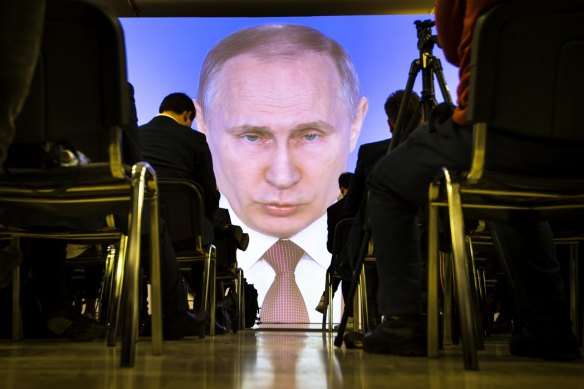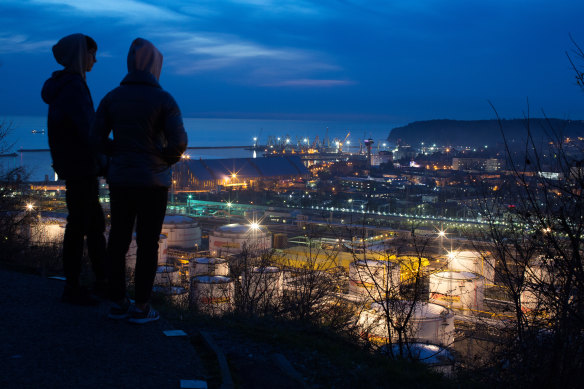This was published 2 years ago
Opinion
Russia’s oil clock is ticking down. How Putin reacts will affect us all
Stephen Bartholomeusz
Senior business columnistThe oil market is awash with rumours and speculation in the lead up to the imminent imposition of a price cap on Russia’s oil exports.
On Monday the Wall Street Journal reported that Saudi Arabia and other OPEC members were discussing a 500,000 barrels a day increase in their production only a little more than six weeks after OPEC and Russia agreed a two million barrels a day cut to their output.

The consequences of the price cap on Russian oil are uncertain for all parties.Credit: AP
The report, quickly denied by the Saudis, cited concerns about the impact of the efforts by the G7 countries, with Australia, to impose a price cap, backed by sanctions, on Russia’s oil exports as well as pressure from some large OPEC producers, notably the United Arab Emirates and Iraq, for increases in their production ceilings.
The “OPEC+” cartel (the “+” includes Russia) is scheduled to meet in Vienna on December 4, a day after a European ban on Russian oil and the proposed price cap are due to come into effect.
An increase in OPEC’s production to offset reduced Russian output is possible – the relationship between Russia and the core of OPEC is one of convenience, with differences of opinion surfacing from time to time – and could reflect an easing of tensions between the US and the Saudis after the Biden administration told a US court last week that Saudi Crown Prince Mohammed bin Salman should be granted immunity in a civil lawsuit that was filed against him over the 2018 murder of journalist Jamal Khashoggi.
Tensions had flared after the OPEC production cuts last month despite intense lobbying efforts by the administration, with the US threatening to cut off arms sales and threatening to enact the “NOPEC” legislation, a bill that would remove OPEC’s anti-trust exemption. The more cynical within the administration saw the cuts as OPEC helping Russia to maintain the oil revenues that are its main source of financing for the war.
The US has also been anxious about the prospect of oil prices, and US fuel prices, soaring again if Europe’s ban on imports of Russian oil, which will apply from December 5, were to reduce the supply of oil to the global market.
That’s why it came up with the concept of the cap because it wanted to ensure that Russian oil kept flowing into the global market after the European embargo came into effect. It was concerned that any significant reduction in Russian output would lead to a spike in already-elevated oil prices and add to the inflationary pressures already ravaging the US and other economies.
The cap is designed to put a ceiling on the price of Russian oil above Russia’s cost of production to provide an incentive for Russia to maintain production but at a material discount to international prices in order to reduce its oil revenues and ability to finance the war against Ukraine.
That price, probably set somewhere between $US40 and $US60 a barrel, is expected to be announced this week, perhaps as early as Wednesday.

Europe is heavily dependent on Russia for its oil and gas.Credit: Bloomberg
The cap will be supported by a ban on shipping, finance and insurance for any sales of Russian oil at prices above the cap, with the UK dominance of the insurance market for shipping – about 90 per cent of the insurers are in the UK or Europe – the key to enforcing the cap.
Whether the cap and the threat of the accompanying sanctions on shipments priced above the cap will be effective is a matter of some debate, particularly since the major buyers of Russian oil since the invasion – China and India – aren’t parties to the G7 agreement.
With interest rates in the major economies rising through this year to levels not seen for decades there is already the prospect of a global recession. A surge in oil prices would probably both guarantee one and exacerbate its effects.
The cap offers China, India and others that have been buying Russian oil since the invasion both a carrot and a stick.
Russia has already been discounting its oil quite significantly to attract buyers – China and India have been getting discounts of $US25 to $US30 a barrel from international prices – and the US hopes that the buyers will be driven by self-interest and use the cap as leverage to get even cheaper supply.
Russia has two broad responses it can make to the G7 actions. It can try to circumvent them by insuring and financing its shipments itself or by using some of the sanctions-busting techniques that its new ally Iran has perfected or it could, as it has threatened, simply refuse to supply to anyone who agrees to implement the price cap.
It could even simply shut in production in the expectation that the subsequent spike in prices would hurt the West more than Russia and fragment the surprisingly cohesive support the Ukrainians have attracted from some of the world’s major economies.
A significant reduction in Russia’s production could force oil prices up dramatically – there are estimates of prices of $US200 a barrel or more – but might come at a long-term cost to Russia as its wells and infrastructure, already impacted by the withdrawal of western investment, expertise and technology, could be permanently damaged by any lengthy interruptions to production.
That might not deter Vladimir Putin, who has demonstrated by cutting of gas supplies into Europe earlier this year he is driven more by his immediate military and geopolitical objectives than concerns about Russia’s economy or its already-diminishing economic future.
Whether the more dire predictions of what Russia might do and the impact that might have on the supply and price of oil globally might actually eventuate is uncertain and only partly hinge on how effective, or not, the price cap and the mechanism to police it might be.
Whether the more dire predictions of what Russia might do and the impact that might have on the supply and price of oil globally might actually eventuate is uncertain and only partly hinge on how effective, or not, the price cap and the mechanism to police it might be.
Despite OPEC+’s production cuts, the oil price today is, at just below $US88 a barrel, more than 10 per cent lower than when those cuts were announced and more than 30 per cent lower than their peak of about $US128 a barrel in early March in the immediate aftermath of the invasion.
With the US (possibly) and Europe (probably) apparently headed for recessions, or at least something that feels like a recession, and China’s already anaemic growth threatened by another outbreak of COVID that will make it difficult for Beijing to back away from the “zero COVID” policies that have been a major factor in that weakened growth, demand for oil is itself likely to weaken.
Even without the price cap and embargoes, that would blunt, to some degree at least, the impact of reduced Russian supply in the near term.
In the longer term Russia’s pariah status in much of the world and/or any new surge in oil and gas prices will provide incentives for increased oil and gas production or the more rapid development of alternate energy sources elsewhere.
The Market Recap newsletter is a wrap of the day’s trading. Get it each weekday afternoon.